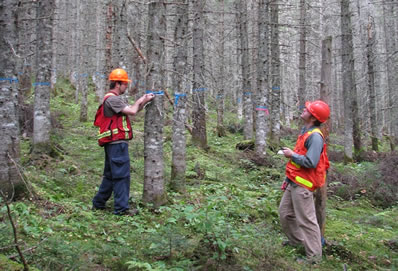Silvicultural research
Increasing forest stand production with high-quality silvicultural data
Canada’s forest sector grew out of the country’s abundant and easily accessible forest resource. The low-cost supply of high-quality wood, coupled with relatively relaxed regulations in much of the 20th century, generated a forest-based prosperity that supported corporations, individuals, whole communities and provinces.

Measuring and assessing the quality of trees at the Green River pre-commercial thinning trial
Today, forest activities are much more closely regulated, and intensified competition from international suppliers is testing Canada’s trading strength in the forest products market. The forest sector transformation initiative underway is addressing these challenges, looking to innovation—through, for example, the use of new technologies and product diversification—to sharpen the industry’s competitive edge and ability to stay economically sustainable.
Does that mean the traditional forest products industry is disappearing? Not at all. As projects like the Bio-pathways project of the Forest Products Association of Canada show, the traditional industry is as important as ever. And this makes having an affordable, stable wood supply essential.
Building that wood supply involves both:
- renewing harvested stands to fully stocked stands of valuable species as quickly as possible so that the new forest will be at least as valuable as the one it replaces; and
- managing existing stands to maximize product quality, quantity and, subsequently, value.
Finding ways to accomplish those goals is the objective of much research underway by the Canadian Forest Service of Natural Resources Canada and its partners. At the Canadian Wood Fibre Centre (CWFC), for example, many silvicultural studies are aimed at helping forest managers and policy-makers identify strategies for lowering production costs, increasing the volume and quality of raw material produced, while still maintaining landscape-level ecological function, diversity and sustainability.
Some of the CWFC’s research installations are more than 70 years old, established in hardwood, boreal and Great Lakes–St. Lawrence forest zone mixedwoods, as well as in pure and mixed conifer stands. Long-term studies at these sites are yielding data with which forest managers can make better-informed decisions about silvicultural investments (see examples in the text box). The data is also providing essential support to policy-makers in developing and revising guidelines for recommended silviculture practice. As well, transfer of this invaluable knowledge from researcher to the entire practitioner field occurs through CWFC, FPInnovations and forest extension groups across the country, and through direct communications with forest industry and provincial agencies.
In all these ways—supporting decision-making, increasing resource value and identifying production efficiencies—silviculture research like that of the CWFC is helping the Canadian forest industry stay competitive in today’s global market.
Examples of CWFC silvicultural research underway
- Full value-chain economic analyses – Total costs of stand establishment, tending, harvesting and processing, as well as the value of what is produced, are being quantified and used in cost-benefit analyses to help identify optimal forest production strategies.
- Density management – The effects of pre-commercial thinning and commercial thinning treatments on wood quality and value are being studied in conifer and hardwood stands to determine optimal density management regimes.
- Boreal mixedwood silviculture and management – Studies on renewal, stand tending options and partial harvest systems for this common forest type aim to identify treatments that will balance the productivity of both hardwoods and softwoods.
- Silvicultural treatment effects – The effects of site preparation, vegetation control, fertilization and other silvicultural treatments on production, wood quality and economics are being evaluated, and the information used to identify treatment regimes with good economic return.
- Operational biomass harvesting trials – Operational trials in Great Lakes–St. Lawrence low-quality mixedwood and tolerant hardwood stands are investigating the feasibility and long-term sustainability of harvesting biomass as a means both to restore degraded sites and to provide material to the emerging bio-economy.
Canadian Forest Service key contact
Michael Hoepting, Silviculture Research Forester
Page details
- Date modified: